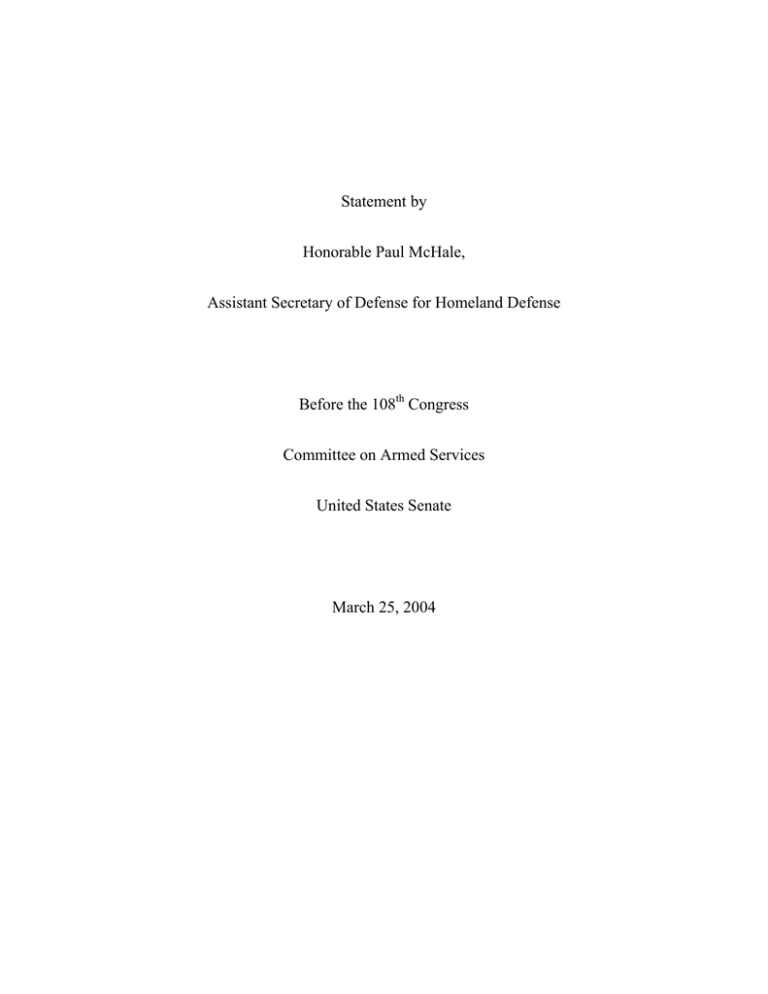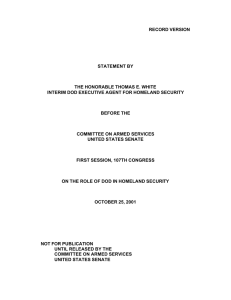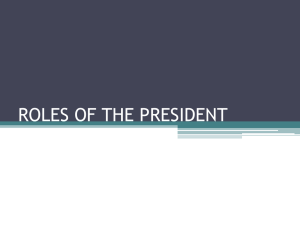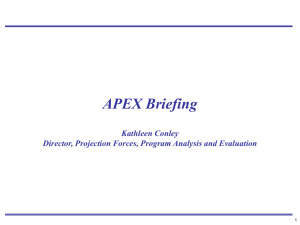Statement by Honorable Paul McHale, Assistant Secretary of Defense for Homeland Defense
advertisement

Statement by Honorable Paul McHale, Assistant Secretary of Defense for Homeland Defense Before the 108th Congress Committee on Armed Services United States Senate March 25, 2004 Introduction Chairman Warner, Senator Levin, distinguished members of this Committee: Thank you for inviting me back to address the critical subject of our Nation’s security. I appreciate the opportunity to return today to update you on our progress. When I appeared before this Committee a year ago, new Department of Defense (DoD) organizational structures for homeland defense were still under development. With a continuing sense of urgency and focus, DoD has implemented substantial improvements in homeland defense capabilities over the past year, increasing the safety of the nation. At the same time, there is no reason for complacency. We fully recognize that significant challenges lie ahead. Through prosecution of the Global War on Terror, DoD focuses on combating terrorism as far from our borders as possible. Thus, our first line of defense is abroad -to confront the enemy where they live, train, plan, and recruit, as we are doing today in Afghanistan and Iraq. The second line of defense also lies beyond the borders of the Nation -- the air and maritime avenues of approach – where we will engage terrorists before they reach our borders. Inside our borders, the domestic law enforcement community is responsible for countering terrorist threats; DoD stands ready to provide capabilities in support of civil authorities, consistent with U.S. law. Within the Office of the Secretary of Defense, under the leadership of the Under Secretary of Defense for Policy, my office and that of my colleague, the Assistant Secretary of Defense for Special Operations and Low Intensity Conflict (ASD(SO/LIC)), work together to provide policy guidance and to supervise DoD’s homeland defense and combating terrorism activities here in the United States and around the world. The combatant commanders of U.S. Northern Command and U.S. Special Operations Command, also present today, lead our combating terrorism operations. Together, we combat terrorism at home and abroad, while diligently working to mitigate any potential 1 policy and operational seams. My testimony today will address DoD homeland defense activities that have occurred since my last appearance, as well as the challenging work that lies ahead. Additionally, I will describe some of the key issues where homeland defense and combating terrorism intersect within our common fight against global terrorism. DoD’s Role in the Security of Our Nation: Combating Terrorism Within the Department of Defense, our combating terrorism activities comprise four main areas: • Antiterrorism -- defensive measures taken to reduce vulnerabilities and protect our personnel, facilities, and resources against a terrorist incident; • Counterterrorism -- offensive response measures taken to deter, preempt, and resolve a terrorist act; • Consequence Management -- efforts to prepare for and respond to the aftermath of a terrorist event; and • Intelligence -- the collection, analysis, and dissemination of terrorismrelated information. Within the Office of the Secretary of Defense, the responsibility for combating terrorism involves three main entities. First, the Bob Stump National Defense Authorization Act for Fiscal Year 2003 (Public Law 107-314) assigned responsibility for the overall direction and supervision for DoD’s combating terrorism activities to the Under Secretary of Defense for Policy. Second, in accordance with Section 138(b)(4) of Title 10, U.S. Code, my colleague, the Assistant Secretary of Defense for Special Operations and Low Intensity 2 Conflict (ASD(SO/LIC)), is responsible for the overall supervision of DoD’s special operations and low intensity conflict activities. Third, as requested by the Secretary of Defense, Public Law 107-314 also established the Office of the Assistant Secretary of Defense for Homeland Defense. I am honored to serve as the first Assistant Secretary of Defense for Homeland Defense (ASD(HD)). My office was established to assist the Secretary of Defense in improving policy and providing guidance to combatant commanders regarding the air, land, and maritime defense of U.S. territory and the provision of defense support to civilian authorities. As stated in the establishing statutory language, I provide overall supervision of the homeland defense activities of DoD. DoD’s Role in the Security of Our Nation: Homeland Defense As you know, following the terrorist attacks on the United States of 9/11, at the direction of the President and with Congressional support, DoD moved quickly to establish new organizations focused on homeland defense and civil support: U.S. Northern Command (USNORTHCOM) and the Office of the Assistant Secretary of Defense for Homeland Defense noted above. You will recall that on October 1, 2002, DoD activated USNORTHCOM, headquartered in Colorado Springs, Colorado. NORTHCOM conducts operations within its assigned area of responsibility to deter, prevent, and defeat threats and aggression aimed at the United States, its territories, and interests. Accordingly, as directed by the President or Secretary of Defense, the Commander, USNORTHCOM, would direct military operations within its area of responsibility, including combat operations. In addition, when directed by the President or Secretary of Defense, the Commander, USNORTHCOM, would also provide support to U.S. civil authorities, including military 3 assistance to civil authorities, military support to civilian law enforcement agencies, military assistance for civil disturbances, and incident management operations in response to a weapon of mass destruction (WMD) attack. USNORTHCOM’s area of responsibility includes the continental United States, Alaska, Canada, Mexico, and the surrounding water out to approximately 500 nautical miles. The defense of Hawaii and U.S. territories and possessions in the Pacific remains the responsibility of U.S. Pacific Command. The Commander of USNORTHCOM is also the commander of the bi-national U.S.-Canada North American Aerospace Defense Command (NORAD). USNORTHCOM achieved full operational capability on September 11, 2003, and is fully able to conduct missions assigned to the command by the President in the Unified Command Plan. As the first combatant command with a primary mission to defend the land, sea, and air approaches to the United States, USNORTHCOM operations extend to all three domains. Air domain. NORAD guards, patrols, and monitors the airspace over Canada and the United States. Each and every day the men and women of the United States Air Force, United States Air Force Reserve, and the Air National Guard secure the skies over major metropolitan areas, our nation’s critical infrastructure, and historic monuments. Since September 11, 2001, these dedicated professionals have executed over 34,000 air defense sorties and responded to over 1,700 requests from the Federal Aviation Administration to intercept potential air threats. Maritime domain. Similarly, the U.S. Navy monitors the sea approaches to the United States and works with the U.S. Coast Guard to patrol international waters and our territorial seas. On a daily basis, U.S. Navy sailors vigilantly monitor the blue water approaches to our Nation’s territorial seas, operating under new and expanded authority 4 to interdict vessels potentially bearing terrorists or their weapons before they reach our shores. Further, under Operation NOBLE EAGLE, naval maritime surveillance and engagement forces are designated for transfer to USNORTHCOM command and control when directed by the Secretary of Defense. Land domain. The Homeland Security Act of 2002 (Public Law 107-296) assigns the Secretary of Homeland Security the responsibility for the security of the Nation’s borders. That responsibility includes preventing terrorists and instruments of terrorism from penetrating our borders, protecting our ports of entry, immigration enforcement, and ensuring the speedy, orderly, and efficient flow of lawful traffic and commerce. DoD’s role in that border security mission is to provide support to civil authorities, principally the Department of Homeland Security (DHS), when appropriate. DoD has established and maintains Quick Reaction Forces and Rapid Reaction Forces, which, when deployed, will operate under USNORTHCOM command and control. These highly trained U.S. Army and Marine Corps personnel are postured to respond to the full range of potential threats to the United States. Homeland Defense and Homeland Security Exercises DoD is committed to maintaining the readiness of military forces to execute the full spectrum of homeland defense operations and to support civil authorities, when necessary and appropriate. To this end, DoD has hosted its own exercises and participated in exercises sponsored by other government entities. Over the last year, these included: Unified Defense (February 2003); TOPOFF 2 (May 2003); Determined Promise (August 2003); Livewire (October 2003); Unified Defense (February 2004); and Senior Official Exercise #3 (March 2004). These exercises addressed a range of potential threats to the United States, from cyber attacks to bioterror attacks, and from radiological attacks to a nuclear detonation. The exercises support the DHS National Homeland Security Exercise Program established by the December 2003 Homeland Security 5 Presidential Directive-8 (HSPD-8) on National Preparedness. Homeland security and homeland defense exercises are critical in identifying gaps and potential weaknesses within each agency and across agencies in responding to terrorist attacks, including multiple, simultaneous challenges. . DoD Support of Critical Infrastructure Protection The Homeland Security Act of 2002 (Public Law 107-296) assigned DHS the responsibility to develop a comprehensive national plan to protect our nation’s critical infrastructure and key assets. The National Strategy to Secure Cyberspace (February 2003) and the National Strategy for the Physical Protection of Critical Infrastructure and Key Assets (February 2003), as well as HSPD-7 on Critical Infrastructure Identification, Prioritization, and Protection (December 2003), designate DoD as the sector-specific agency for the Defense Industrial Base sector. This designation recognizes DoD’s important role in the protection of critical defense installations and facilities. In this capacity, DoD must work closely with private sector owners of critical defense infrastructure to deter, mitigate, or neutralize terrorist attacks in order to sustain military operations. In September 2003, the Secretary of Defense assigned me the responsibility for Defense Critical Infrastructure Protection. Since then, we have consolidated Critical Infrastructure Protection (CIP) funding within the Office of the Secretary of Defense into a single program, managed by the newly established Defense Program Office for Mission Assurance. Under my oversight, this office conducts focused research and development using a systems approach for CIP activities supporting DoD missions. We have also taken steps to increase the preparedness of critical defense installations and facilities against chemical, biological, radiological, and nuclear threats. Pentagon efforts are helping to develop DoD-wide installation preparedness standards and requirements, which we will apply at 200 other key installations over the next few years. 6 DoD Relationship with the Department of Homeland Security DoD focuses on and is responsible for homeland defense, which is the protection of United States territory, domestic population, and critical defense infrastructure against external threats and aggression. It also includes routine, steady-state activities designed to deter aggressors and to prepare U.S. military forces for action if deterrence fails. DHS, on the other hand, focuses on homeland security, which is defined in the 2002 National Strategy for Homeland Security as “a concerted national effort to prevent terrorist attacks within the United States, reduce the vulnerability of the United States to terrorism, and minimize the damage and assist in the recovery from terrorist attacks.” In simpler terms, the Defense Department provides the military defense of our nation from all attacks that originate from abroad, while DHS protects the nation against, and prepares for, acts of terrorism. DoD is organized and prepared, however, at the direction of the President and the Secretary of Defense, to play a vital role in support of the DHS mission. As the Secretary of Defense’s principal representative to the DHS, I have worked hard to build upon our excellent working relationships throughout the Department of Homeland Security. We have nearly completed a memorandum of agreement with DHS, under which DoD will continue to provide, some 64 detailed personnel to DHS to fill critical specialties, principally in the areas of communications and intelligence. We have also established a 24/7 DoD presence in the DHS Homeland Security Operations Center with direct connectivity back to DoD for rapid response. Additionally, we established planning teams to assist the DHS Interagency Incident Management Group – a group of senior interagency officials focused on incident response. This year, we are further enhancing our partnership with DHS by establishing a DoD advisory and liaison office -called the Homeland Defense Coordination Office -- within DHS headquarters. 7 In accordance with Section 1401 of Public Law 107-314, I also serve as the “senior official of the Department of Defense to coordinate all Department of Defense efforts to identify, evaluate, deploy, and transfer to Federal, State, and local first responders technology items and equipment in support of homeland security.” In that capacity, I work closely with the DHS Under Secretary for Science and Technology. Recent examples of technology transfer initiatives include: information-sharing systems, such as the Disaster Management Interoperability Services; biometrics identification technologies; ground sensors and their application in border security; and unmanned aerial vehicle experimentation. Additionally, new Advanced Concept Technology Demonstration (ACTD) efforts are underway that have the potential to deliver capabilities supporting both DoD missions abroad and DHS missions at home. DoD Relationship with the Homeland Security Council The President established the Office of Homeland Security (OHS) and the Homeland Security Council (HSC) on October 8, 2001 to develop and implement a comprehensive national strategy to secure the United States from terrorist threats. In the Homeland Security Act of 2002, Congress created the Department of Homeland Security and codified the Homeland Security Council. DoD coordinates with the Assistant to the President for Homeland Security and staff as appropriate. The Secretary of Defense is, along with the President, Vice President, Secretary of Homeland Security, and the Attorney General, a statutory member of the HSC. DoD worked closely with the OHS from October 2001 to March 2003, and continues to do so with its successor, the HSC staff. As ASD(HD), I am DoD’s principal representative to the HSC staff. My office represents DoD on the HSC’s interagency policy coordination committees (PCCs) and subordinate working groups, with the participation of other DoD offices as appropriate. From personal experience, I can attest that the HSC has become an effective forum for 8 interagency communication on homeland security and homeland defense matters, including evaluation of terrorist threats and the development of responses in a crisis environment. As one recent example, the HSC functioned effectively throughout the tense weeks of Code Orange alert during the December 2003 holiday season. Defense Support to Civil Authorities DoD has a long tradition of support to civil authorities as necessary and appropriate while maintaining its primary mission of fighting and winning the Nation’s wars. Since my last testimony before this Committee, DoD has continued to lend necessary assistance to civil authorities when they were overwhelmed or faced with challenges necessitating the Department’s unique capabilities. Last year we acted on 75 requests for assistance from more than 20 civilian agencies, including DHS, the Department of Justice, the Department of Health and Human Services, the Department of Transportation, the Department of State, the National Air and Space Administration, the U.S. Marshals Service, and the National Interagency Fire Center. To provide several brief examples of civil support activities last year, DoD provided emergency support in natural disasters such as Hurricane Isabel in September 2003 and the October 2003 California wildfires. DoD also provided support in responding to incidents such as the Columbia space shuttle accident in February 2003 and the January 2004 ricin incident on Capitol Hill. For the latter, USNORTHCOM’s Joint Force Headquarters-National Capitol Region, in its first operational use, provided command and control of U.S. Marine Corps Chemical-Biological Incident Response Force assistance to the U.S. Capitol Police. Internal DoD Combating Terrorism Collaboration As described at the outset, combating terrorism includes a spectrum of activities that do not correspond neatly with geographic boundaries on a map or organizational boundaries within agencies. For example, the ongoing crisis in Haiti clearly requires the 9 type of stability operations expertise resident in OASD(SO/LIC). At the same time, in light of Haiti’s proximity to the United States and potential homeland security dimensions of the situation, my office has been instrumental in facilitating coordination with DHS, the overall lead Federal agency on the migration aspects of this evolving issue. Similarly, terrorist use of man-portable air defense systems (MANPADS) is a threat that does not respect borders. Thus, my office participates in an Interagency MANPADS Task Force to advance measures to reduce the vulnerability of aircraft to missile attacks domestically, while OASD(SO/LIC) participates in interagency efforts to deny terrorists access to missiles throughout the world. The witnesses testifying before you today work diligently to ensure that “seams” do not hinder our combating terrorism efforts as we work to deter, dissuade, defend, and defeat potential terrorist attacks against the United States and our interests around the world. Antiterrorism. Within the United States, the Military Departments are responsible for force protection and taking appropriate defensive antiterrorism measures to protect their military facilities and personnel. Outside the United States, regional combatant commanders have these responsibilities. We are currently in the process of examining policy options for antiterrorism and force protection for DoD facilities and personnel within the United States to determine whether any changes are needed in the assignment of these responsibilities. Counterterrorism. Offensive measures overseas to deter and preempt terrorist attacks, largely a mission for special operations forces, are crucial to preventing terrorist activities against the United States. For overseas counterterrorism operations, we rely on ASD(SO/LIC) for policy oversight and the Commander, Special Operations Command, for their execution. Domestic counterterrorism is first and foremost a civilian law enforcement function. By design, DoD’s counterterrorism role within the United States 10 is constrained. DoD provides military support to civilian law enforcement agencies (MSCLEA) consistent with applicable law and under my supervision. Authorized support under title 10, U.S. Code includes information sharing, loan of equipment and facilities, expert advice and training, and maintenance and operation of equipment. Consequence Management. The preparations for and response to terrorist events vary depending on the location of an incident. My office is responsible for DoD’s support to civil authorities for domestic incident management, while ASD(SO/LIC) is responsible for DoD’s support to the Department of State, which has the lead for foreign disaster assistance and foreign consequence management. There are multiple linkages between incident and consequence management, however. These include sharing information obtained in the course of incident and consequence management-related interagency deliberations and relevant exercises. Through formal bilateral exchanges and visits with our allies and friends, we also engage in information sharing and coordination regarding the preparedness and consequence management activities of other nations. These activities not only enhance preparedness and response capabilities across the board, but also strengthen our alliances in the Global War on Terror. In the case of a domestic WMD attack, as necessary and appropriate, the Joint Task Force Civil Support headquartered in Norfolk, Virginia; the Joint Task Force Consequence Management East headquartered at Fort Gillem, Georgia; or the Joint Task Force Consequence Management West headquartered at Fort Sam Houston, Texas; under the command and control of the Commander, USNORTHCOM, would be available to provide incident management support to civil authorities. Additionally, we are working to strengthen DoD and civilian capabilities and surge capacity to address multiple, simultaneous CBRN attacks in the United States. 11 Intelligence and Information Sharing. Throughout DoD we work closely with the constituent elements of the Intelligence Community to maintain maximum awareness of potential attacks against and emerging threats to the United States. My office and OASD(SO/LIC) both engage actively with the Under Secretary of Defense for Intelligence (USD(I)), established in 2003 by Public Law 107-314, on all intelligence matters. USD(I) is charged with ensuring that the senior DoD leadership receives the warning, actionable intelligence, and counter-intelligence support needed to pursue all of the objectives of the updated defense strategy, including defense of the homeland. USD(I) also provides a single point of contact for coordination of national and military intelligence activities with the Community Management Staff under the Director of Central Intelligence (DCI) and strengthens the relationship between the Secretary of Defense and the DCI. Additionally, DoD is a full partner in the Terrorist Threat Integration Center (TTIC), a multi-agency joint venture announced by the President in the January 2003 State of the Union address and launched in May 2003. TTIC integrates terrorist-threat related information, minimizing any seams between analysis of terrorism intelligence collected overseas and inside the United States, to form a comprehensive threat picture. On a daily basis, TTIC coordinates terrorist threat assessments with partner agencies, including DoD, DHS, the Federal Bureau of Investigation, the Central Intelligence Agency, and the Department of State. Additional Internal DoD Areas of Collaboration In addition to collaboration across the range of combating terrorism activities, OASD(HD), OASD(SO/LIC), USNORTHCOM, and USSOCOM also work together on other issues where there is a nexus between combating terrorism and other functional activities. 12 Counternarcotics. Counternarcotics is an area in which DoD has longstanding relationships with civil authorities, including U.S. border and law enforcement officials. By statute, DoD is the lead Federal agency for the detection and monitoring of aerial and maritime movement of illegal drugs toward the United States. DoD works with civil authorities to transmit information to enable law enforcement authorities to interdict such trafficking. DoD also supports requests from the Department of Justice, DHS, and the High Intensity Drug Trafficking Area (HIDTA) Task Force Headquarters for unique military assistance, such as reconnaissance (ground-based, aviation-based, and maritime), logistics, transportation, engineer support along the southwest U.S. border, as well as intelligence programs and training. Within the Office of the Secretary of Defense, ASD(SO/LIC) has the overall lead for DoD’s counternarcotics activities, with assistance from OASD(HD), on issues with domestic implications. Since 9/11, policy and operational changes in DoD have improved the alignment of resources and efforts where there is a link between terrorism and narcotics trafficking. Additionally, NORTHCOM is now charged with counternarcotics activities in its area of responsibility, including counternarcotics support to domestic law enforcement authorities and command of Joint Task Force-6 (JTF-6), headquartered in El Paso, Texas. Further areas of cooperation related to counternarcotics include: • OASD(HD) support to ASD(SO/LIC) on drug interdiction and counternarcotics activities plans developed by U.S. states and territories in accordance with Section 112 of Title 32, United States Code; • Collaboration to shape the future of JTF-6, originally established in November 1989 to provide DoD counternarcotics support to Federal, regional, state and local law enforcement agencies and assigned since October 1, 2002 as a component of USNORTHCOM; and 13 • DoD installation of secure internet systems in many of the HIDTA intelligence centers across the United States that facilitate sharing of counternarcotics-related information with national security and homeland security value. Technology research and development. Research and development represents a final area of combating terrorism collaboration. DoD invests nearly $100 million yearly in the Technical Support Working Group (TSWG), a U.S. national forum that brings together over 85 Federal agencies to identify, prioritize, and coordinate interagency and international research and development requirements for combating terrorism. Within DoD, ASD(SO/LIC) is the executive director and proponent for TSWG. The TSWG rapidly develops technologies and equipment to meet the high-priority needs of the combating terrorism community. Many of these technologies are also applicable to first responders and other homeland security missions. In recognition of that synergy, DHS has joined as a partner in the TSWG, and TSWG staff are also members of the Homeland Defense Technology Working Group. Conclusion Throughout our history, U.S. military forces – Active Duty, National Guard, and Reserves -- have defended our nation against its enemies on land, at sea, and in the air, adapting continuously to engage threats to our nation. Today we face a challenge that is equal to or greater than any we have ever faced before. We must cope not only with the threats produced by the proliferation of weapons of mass destruction (WMD) and missile technology among nation-states, but also with WMD threats posed by individual terrorists and terrorist organizations with global reach. 14 Throughout DoD we are transforming, increasing our capabilities for combating terrorism and homeland defense on a daily basis, while continuing a long tradition of support to civil authorities. Homeland defense and homeland security are featured on Secretary Rumsfeld’s top priorities list for this year. To support his priorities, we intend to develop a comprehensive Homeland Defense Strategy for the 21st century. This strategy will support the National Security Strategy, the National Strategy for Homeland Security, and the updated Defense Strategy. It will also provide the framework for pursuing operational capabilities to prepare for tomorrow’s challenges. Mr. Chairman, I commend you and the members of this Committee for your continued interest in and efforts in support of the Department’s combating terrorism and homeland defense missions. The citizens of this Nation, its institutions, and our brave men and women in uniform have repeatedly demonstrated the patriotism, toughness, innovation, determination, and resiliency to defeat our enemies while retaining our freedoms. There is no doubt in my mind that those capabilities will be tested against this newest enemy threat – nor is there any doubt that we will prevail. 15







